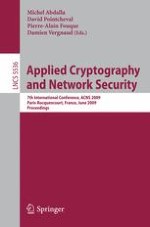2009 | Book
Applied Cryptography and Network Security
7th International Conference, ACNS 2009, Paris-Rocquencourt, France, June 2-5, 2009. Proceedings
Editors: Michel Abdalla, David Pointcheval, Pierre-Alain Fouque, Damien Vergnaud
Publisher: Springer Berlin Heidelberg
Book Series : Lecture Notes in Computer Science
